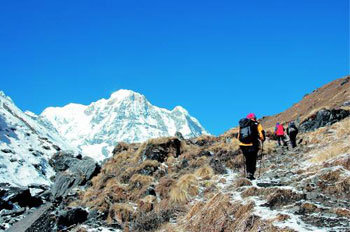Those Who Have Been to the Himalayas and Those Who Havent
Those Who Have Been to the Himalayas and Those Who Havent
Posted December. 01, 2005 03:22,

The Himalayas are known as the roof of the world, thanks to its high-altitude mountains covered with ice caps. Even people that dont like climbing may have thought of visiting there at least once. About 50,000 visitors from every corner of the word come to Nepal to see the Himalayas every year. It is estimated that 8,000 Korean tourists visit Nepal in one year, and that 5,000 out of them actually trek the Himalayas. Dong-A Ilbo will cover Himalayan Trekking with Park Young-seok (second from right, photo) in three installments.
26 participants, including comic artist Hurh Young-man
What is the actual attraction of the Himalayas? We cannot know without actually experiencing them. So we followed Park Young-seok (42, Goldwin Korea Director), who achieved the first ever alpine grand slam, to Annapurnas southernmost base camp, located 4,130 meters above sea level, from November 18 through 29 on a tour prepared by the outdoor apparel company Goldwin Korea, which sells The North Face brand. The tour drew 26 trekkers, including famous climbing fanatic, comic artist Hurh Young-man.
Courses offered according to skill level
Trekking, which is said to derived from the Dutch word meaning traveling, usually implies hiking up mountains about 5,000 to 6,000 meters above sea level, and is different from climbing, where one climbs to higher altitudes. In particular, when one wants to climb high altitude mountains in Nepal, one has to pay tens of thousands of dollars in fees, so base camps are the places where average people that just want a glimpse of high altitude mountains can visit. There are 32 tourist packages available, ranging from a one-day trip to a sherpa village to a 20-day visit to Kangchenjunga (8,598 m) base camp.
Crossing two 2,000-meter mountains in a single day
The trekking course we took was a classic route for seeing Annapurna that starts at Fedi (1,130 m) and proceeds to Chomrong (2,170 m), Machhapuchre base camp (3,700 m), Annapurna base camp (4,130 m), and finally to Nayapul (1,070 m). We walked for a good seven to eight hours every day. Park emphasized, The absolute rule of trekking is not to push yourself over your limit. The average speed was a meager 2km per hour.
Altitude sickness
High altitude sickness usually occurs above 2,800 meters, and its symptoms are headaches and vomiting. If severe, it can lead to water in the lungs and brain, which might lead to death. About three people die from altitude illness in Nepal every year. This is the reason why the trekking is slow paced, and repeatedly up and down is to increase ones ability to adapt to high altitudes. Three out of the 26 participants showed signs of altitude illness and failed to reach base camp.
Surrounded by a wall of icecaps
Almost all the participants suffered headaches when going from Deunali (3,200 m) to Annapurnas base camp at 4,130 meters, a surge of 930 meters vertically. However in front of us was the summit of Annapurna, west of Annapurnas southern apex (7,219m), to the east, and Tarpuchul (5,695 m) and Machhapuchre (6,997 m) to the south.
It is hard to describe the great feeling of being surrounded by such massive ice caps. As if on cue, both Park and Hurh said, This is why people who have been to the Himalayas are different from those who havent.
Chang Jeon jeon@donga.com







